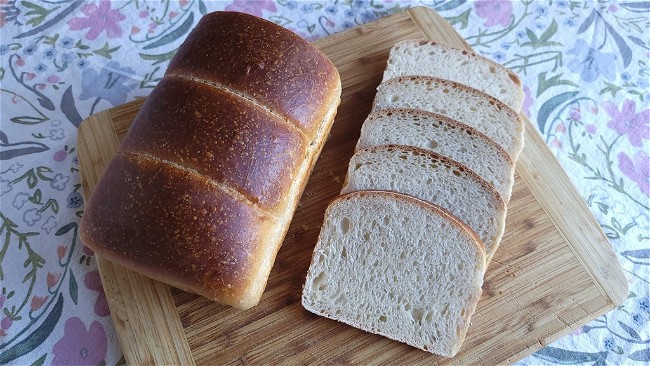Basic All Purpose Sourdough Sandwich Bread
Enjoy this basic sourdough sandwich bread made with all purpose flour. The bread has a soft, tender texture and is buttery, with a hint of sweetness and a subtle complexity that you will never find in bread from a grocery store. It works great for toast, and of course, sandwiches.
Basic All Purpose Sourdough Sandwich Bread
Rated 4.6 stars by 10 users
Category
Sourdough Bread
Servings
1 Loaf
Prep Time
25 minutes
Cook Time
55 minutes
Enjoy this basic sourdough sandwich bread made with all purpose flour. The bread has a soft, tender texture and is buttery, with a hint of sweetness and a subtle complexity that you will never find in bread from a grocery store. It works great for toast, and of course, sandwiches.

Ingredients
-
30 grams sourdough starter (2 Tbsp)
-
35 grams Arva Daisy Hard Unbleached Flour (1/4-1/3 cup)
- 35 grams water (2 Tbsp + 1 tsp)
-
430 grams Arva Daisy Unbleached Hard Flour (3 1/3 cups)
- 180 grams water (3/4 cup)
- 100 grams milk (1/3 cup + 1 Tbsp + 1 tsp)
-
100 grams ripe sourdough starter from the build above (1/3 cup)
- 56 grams unsalted butter, softened (4 Tbsp)
-
25 grams sugar (2 Tbsp)
-
8 grams salt (1 1/2 tsp)
Starter Build
Final Dough Ingredients
Directions
Sourdough Starter Build
Early in the day, build 100g sourdough starter by feeding 30g starter with 35g flour and 35g water. Allow this to ripen over the next 3-6 hours. When the starter is at least double in size, it is ready to use in your dough. It is also fine to use starter you fed a few days prior and refrigerated at or close to peak expansion. The bulk fermentation time will simply be longer.
Mixing and Bulk Fermentation
By Hand Combine the dough ingredients in a large bowl and mix thoroughly. Cover and let the dough sit for 15-20 minutes, then stretch and fold the dough and form it into a ball. With a Stand Mixer Add the dough ingredients to the bowl of your stand mixer and mix on low speed with the dough hook attachment for about 1 minute. Then mix on medium speed for another couple of minutes. Scrape down the sides of the bowl and form the dough into a ball.
Cover the dough and let it rise (bulk ferment) until it has almost doubled in size. At warm temps (low 80s) my dough doubled in 5 hours. Colder dough may need more time.
Shaping and Final Proof
Prep a small (8.5 x 4.5 x 2.75 inches) or medium (9 x 5 x 2.75 inches) loaf pan. Unless the pan is non-stick, grease or line it with parchment paper.
Flour your work surface, place the dough on the flour, and shape it into a simple sandwich loaf, a lobed sandwich loaf (or a braid if desired).
Shaping Simple Loaf
Simple loaf. Pat the dough into a square and roll it into a loose tube. Pat the tube down, this time into a rectangle with an 8" short edge. Starting at a short edge, roll the dough again so you have a neat 8-9" long tube. Place it in the pan, seam side down.
Shaping Lobe Loaf (optional)
ivide the dough in four pieces, about 220g each. Roll each piece into a ball. If the dough is tight, let it rest 5-10 minutes. Then flatten each piece into an oblong shape about 3 x 6 inches. Then roll each oblong into a tube starting at a short edge. Place the four tubes in the loaf pan seam side down, alternating the direction of the swirls to encourage upward rise of the dough.
Final Proof
Cover and let the dough rise again (final proof) until it has doubled and is close to the top of the pan. For a smaller loaf pan, the dough may crest over the rim. For a medium loaf pan, the dough will be just under the rim.
The final proof can take place at room temperature for several hours, or with a combination of time at room temperature and in the refrigerator. If refrigerating the dough, do so before it has doubled in case it keeps expanding in the cold. If the dough hasn't doubled by morning, take it out of the refrigerator and let it keep rising.
Baking
Preheat your oven to 375F for about 15 minutes with a shelf one level up from the bottom.
Preheat your oven to 375F for about 15 minutes with a shelf one level up from the bottom.
Bake for 55 minutes, turning the pan halfway if it is browning unevenly. To firm up the bottom and sides of the loaf, take it out of the loaf pan for the last 5-10 minutes of the bake.
When baking is complete, the bread should have an internal temperature of at least 190F.
Brush the still-warm crust with butter or oil to keep it soft.
Let the bread cool for about 2 hours before slicing. Store the bread in a beeswax bag, plastic bag, bread box, or under a bowl on a cutting board.
